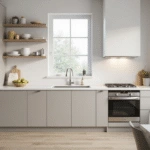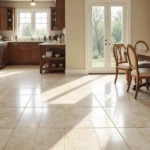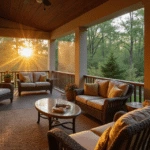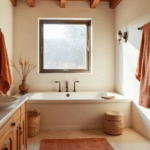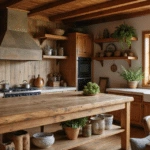As an artist and home integration specialist, I’ve seen how a single piece of furniture can transform a space. Stepping into your living room should feel like entering a sanctuary—a space that reflects your personality and welcomes both relaxation and creativity. At the heart of this haven often sits the humble coffee table. More than just a surface for your morning brew, it’s a design anchor that can subtly or dramatically transform your entire living space.
But here’s the thing—with countless styles, materials, and shapes available, choosing the right coffee table design can feel overwhelming. Whether you’re looking to refresh your space or completely reimagine it, I’ve curated 18 stunning coffee table ideas that will inspire your next living room transformation. From sleek minimalism to functional flexibility, let’s explore designs that balance beauty with practicality.
1. Sleek Minimalist Coffee Tables: Less is Truly More
Minimalist coffee table design strips away the unnecessary, focusing on clean lines and simple forms. These pieces are the quiet sophisticates of the furniture world—they don’t shout for attention, but their refined presence speaks volumes. In my studio work, I’ve found that minimalist tables create a sense of calm and order, offering a visual respite that’s particularly valuable in spaces where creativity can sometimes feel chaotic.

Materials matter immensely in minimalist design. Light-colored woods like birch or maple bring natural warmth without visual heaviness. Glass tabletops create an airy feel and showcase the table’s base, while metals—particularly stainless steel or powder-coated finishes—contribute a modern edge. For those seeking a bolder statement, even concrete works beautifully in minimalist contexts.
“In design, the space between elements is as important as the elements themselves. A minimalist coffee table honors this principle perfectly.” – Zara Williams
Now, consider this—in a living room bathed in soft light, a low rectangular coffee table in light oak with a simple shelf underneath provides discreet storage while keeping the tabletop pristine. This understated elegance sets the stage for both relaxation and creative inspiration.
Here’s where it gets interesting—as we move from refined simplicity into the warm embrace of natural materials.
2. Rustic Charm: Embrace Natural Wood Coffee Table Designs
What makes rustic coffee table design so enduringly appealing? It’s that invitation to bring the outdoors in. These tables celebrate the beauty of natural materials, especially wood in its most authentic form. As someone who works with both art and living spaces, I’m drawn to how visible grain, knots, and even slight imperfections tell a story—they’re not flaws but features that connect us to simpler times and the warmth of nature.

The wood itself is the star in rustic design. Pine, oak, and walnut are popular choices, often finished with natural stains or left untreated to highlight their inherent character. Reclaimed wood elevates this concept further, adding not just rustic charm but also sustainability. I’ve incorporated reclaimed wood coffee tables into studio-living spaces where they provide both practical work surfaces and grounding, natural energy.
- Pair rustic coffee tables with:
- Natural fiber rugs
- Cozy, textured throws
- Earthy tone accessories
- Simple ceramic or stone vessels
Picture a cozy living space where a chunky, live-edge coffee table crafted from reclaimed barn wood takes center stage. Supported by sturdy iron legs, it grounds the room in natural beauty while providing a durable surface for creative projects or casual gatherings. The coffee table design becomes more than furniture—it’s a piece of nature brought indoors.
The surprising part is how easily we can transition from this grounded, natural aesthetic to something with decidedly more retro flair.
3. Mid-Century Modern Coffee Tables: Retro Flair for Today’s Home
Mid-Century Modern coffee table design represents an enduring snapshot of design history. Emerging from the optimism of post-war America, these pieces effortlessly blend form and function with clean lines, tapered legs, and organic shapes. In my work creating spaces for both living and creating, I find these tables particularly versatile—they bring character without overwhelming a room’s aesthetic.

Warm wood tones like walnut and teak are hallmarks of Mid-Century Modern design, lending richness and depth. What makes this style so distinctive is the range of shapes—from classic rectangles and ovals to more playful kidney and boomerang forms. These shapes aren’t just aesthetic choices; they contribute to the functionality and flow of a space, something critical in multi-purpose rooms where art and daily life intersect.
- Iconic Mid-Century Modern elements:
- Tapered, angled legs
- Organic, flowing shapes
- Warm wood tones (especially walnut and teak)
- Minimal ornamentation
- Functional simplicity
Imagine a living space infused with retro elegance, where a walnut coffee table with a rounded rectangular top and signature splayed legs creates a focal point that’s both nostalgic and timelessly relevant. The coffee table design doesn’t just serve practical needs—it’s a conversation piece that bridges past and present design sensibilities.
This is where everything changes though—as we shift from refined retro to something with more raw, urban appeal.
4. Industrial Edge: Coffee Tables with Metal and Raw Wood Accents
Industrial coffee table design embraces an unrefined beauty that feels authentic and grounded. Drawing inspiration from factories and warehouses, these pieces showcase materials like steel, iron, and reclaimed or distressed wood. As someone who navigates the intersection of art studios and living spaces, I appreciate how industrial pieces bring a utilitarian honesty to a room—they’re both functional and visually striking.

The materials in industrial design tell their own story. Metal finishes tend toward the robust and weathered—black iron, aged bronze, and brushed steel pair beautifully with reclaimed pine, distressed oak, or mango wood. Each is chosen for its unique texture and character. In studio environments, these durable surfaces stand up to creative work while bringing textural contrast to softer elements in living areas.
“Industrial coffee tables aren’t just furniture—they’re a statement about finding beauty in function and history in the ordinary.” – Zara Williams
Envision an urban living space where a coffee table with a thick reclaimed wood top supported by a black iron pipe base anchors the room. Exposed brick walls and concrete floors complement this robust centerpiece. This coffee table design choice doesn’t just fill space—it makes a statement about appreciating raw materials and functional aesthetics.
What many people overlook is how easily we can transition from structured industrial style to something far more eclectic and playful.
5. Bohemian Rhapsody: Eclectic Coffee Tables for a Free-Spirited Vibe
Bohemian coffee table design celebrates eclecticism and personal expression. Breaking free from rigid rules, these pieces embrace vibrant colors, global influences, and mixed textures. In my work blending art spaces with living environments, I’ve found bohemian elements particularly supportive of creative energy—they encourage experimentation and visual play while maintaining functionality.

Natural materials like rattan, wicker, and intricately carved wood dominate bohemian tables, often incorporating vintage or upcycled elements. The embellishments are part of the appeal—intricate carvings, colorful tiles, woven details, and globally inspired patterns add layers of visual interest. These details aren’t just decorative; they contribute to the rich, layered story that bohemian design tells in a space.
- Bohemian coffee table styling:
- Layer various textures (woven, carved, smooth)
- Add colorful cushions for floor seating
- Include global elements like Moroccan tea glasses
- Incorporate plants and natural elements
- Display travel souvenirs and meaningful objects
Imagine a vibrant living area where a low, round rattan coffee table with intricate weaving anchors colorful textiles and eclectic art. The bohemian coffee table design becomes a grounding element amid the joyful visual mix, inviting both relaxation and creative inspiration in a space that feels worldly and deeply personal.
The key detail though—is how we can shift from this organic, textural approach to something with more refined glamour.
6. Glamorous Gold: Coffee Tables with Metallic Accents for a Luxe Look
Metallic accents—particularly gold, brass, or copper—add instant sophistication to coffee table design. These gleaming elements catch light and draw the eye, creating visual interest even in simple forms. As someone who designs spaces for both living and creating, I find that metallic elements can elevate a room without overwhelming it, adding a touch of luxury that feels special without becoming pretentious.

Materials that pair beautifully with gold include glass and marble for a sophisticated combination, while dark woods like walnut or ebony provide rich contrast. In my work integrating creative spaces with living areas, I’ve found that metallics reflect light wonderfully, brightening spaces and adding warmth. They create natural focal points that can help define different functional zones in open-plan environments.
“A touch of gold in your coffee table is like jewelry for your living room—it shouldn’t overwhelm but should definitely be noticed.” – Zara Williams
Envision an elegant space where a glass-top coffee table with a gold geometric metal base catches afternoon light. The structured base creates interesting shadows while the transparent top maintains visual lightness. This coffee table design choice brings refinement without heaviness—essential in spaces that need to function for both daily living and creative pursuits.
Let me explain how we can maintain elegance while shifting to a different material combination that emphasizes modern simplicity.
7. Glass and Metal Fusion: Modern Coffee Tables with Elegant Lines
Glass and metal coffee table design offers a sleek, contemporary aesthetic that brings visual lightness to any space. The transparency of glass creates an airy feel while metal provides structure and definition. In spaces where I integrate art studios with living areas, these tables work beautifully—they provide necessary function without visual weight, helping smaller or dual-purpose spaces feel more open and uncluttered.

Different metal finishes dramatically change the character of these tables. Polished chrome creates a sleek, modern feel; brushed stainless steel offers a more subtle, sophisticated look; black powder-coated metal provides bold contrast; while brass or gold finishes add warmth. The glass itself can be varied too—clear for maximum lightness, smoked for drama, or even textured for added interest without sacrificing transparency.
- Tips for glass coffee tables:
- Choose tempered glass for safety and durability
- Consider glass thickness based on table size and use
- Keep glass surfaces clean with microfiber cloths
- Use occasional furniture polish on metal elements
- Place on a rug to define space and add softness
Picture a contemporary living space bathed in natural light, where a rectangular glass coffee table with a minimalist chrome base creates a sophisticated focal point without visual heaviness. This coffee table design choice enhances the sense of spaciousness while still providing the necessary surface for both everyday use and creative projects.
The breakthrough came when designers began focusing not just on materials and style, but on sustainability and uniqueness.
8. Reclaimed Wood Wonders: Sustainable and Unique Coffee Table Designs
Reclaimed wood coffee table design represents a beautiful marriage of sustainability and character. These pieces use wood salvaged from old buildings, barns, or furniture, giving new life to materials with history embedded in their grain. As an artist who values both environmental consciousness and visual storytelling, I find these tables particularly compelling—each one carries its own unique narrative while making a positive ecological impact.

The sustainability aspect of reclaimed wood is significant—using these materials reduces deforestation and the need to harvest new trees. But the benefits extend beyond environmental concerns. Reclaimed wood often brings superior durability, as older wood tends to be stronger and more stable. The aesthetic appeal is undeniable too—the patina, saw marks, nail holes, and color variations create visual interest that new wood simply cannot match.
“A reclaimed wood coffee table doesn’t just fill space in your home—it continues a story that began decades or even centuries ago.” – Zara Williams
Imagine an eco-conscious living space where a substantial coffee table crafted from reclaimed barn wood serves as both functional furniture and conversation piece. Its visible history—perhaps revealed through saw marks, nail holes, or varied coloration—adds character and depth. This coffee table design choice isn’t just practical; it’s a statement about values and an appreciation for authentic materials.
9. Marble Majesty: Luxurious Coffee Tables for a Sophisticated Touch
Marble coffee table design epitomizes timeless luxury and sophistication. This natural stone, with its elegant veining, cool smooth texture, and inherent quality, instantly elevates any space. In my work creating integrated living and studio environments, I’ve found that marble surfaces bring an artisanal quality that resonates with creative spaces—they’re both practical work surfaces and beautiful design elements.

The variety within marble offers rich design possibilities. Carrara marble brings classic white with subtle grey veining, while Calacatta offers more dramatic grey and gold patterns. Nero Marquina flips the script with striking black and white contrast, and Emperador brings warm earthy browns. Each type creates a different mood, allowing you to tailor your coffee table design to your specific aesthetic while maintaining the material’s inherent sophistication.
- Caring for marble coffee tables:
- Use coasters to prevent water rings and stains
- Clean spills immediately to prevent etching
- Apply a quality stone sealer annually
- Use gentle, pH-neutral cleaners
- Consider a glass top for additional protection
Envision a sophisticated living space where a rectangular Carrara marble coffee table with a sleek stainless steel base anchors the room. The natural veining in the stone creates organic patterns that complement both structured and flowing design elements. This coffee table choice makes a statement about appreciation for natural materials and timeless aesthetics.
It all comes down to this—sometimes creating visual impact means embracing transparency and letting other elements shine.
10. Acrylic Artistry: Transparent Coffee Tables for a Contemporary Space
Acrylic coffee table design, also known as lucite, offers a unique visual magic—it’s there but not there, functional yet nearly invisible. These transparent pieces create an almost ethereal effect, seeming to disappear into the room. As someone who designs spaces that must balance creative work with daily living, I appreciate how these tables provide necessary function without adding visual weight—particularly valuable in smaller spaces or rooms with statement art pieces.

The styles range from minimalist clear cubes to more sculptural forms that play with light and perspective. What makes acrylic special is its chameleon-like quality—it takes on the character of what surrounds it. Place it on a vibrant rug, and it captures that color in reflections. Position it near a window, and it throws prism-like patterns when sunlight strikes its edges. These tables are also remarkably durable—more shatter-resistant than glass, making them practical choices for active households.
“An acrylic coffee table is like a functional ghost—it serves a purpose while letting everything around it take center stage.” – Zara Williams
Picture a modern, airy living space where a simple, clear acrylic cube coffee table creates a floating display for a carefully chosen art book and sculptural object. The coffee table design becomes a showcase for these items while maintaining visual openness. This approach works beautifully in spaces where other elements—art, architecture, or textiles—deserve to be the focus.
Here’s the catch—sometimes what we need from our coffee tables isn’t just visual appeal but tactile comfort.
11. Upholstered Comfort: Ottoman Coffee Tables for Relaxed Living
Ottoman coffee table design brilliantly blurs functional boundaries. These soft, upholstered pieces serve multiple purposes—coffee table, footrest, extra seating, and sometimes even storage. In my work creating spaces that support both creative pursuits and comfortable living, these versatile pieces solve multiple problems at once, especially in smaller spaces where furniture needs to work harder.

The upholstery options are vast and can dramatically change the character of the piece. Leather brings sophistication and durability; velvet adds rich texture and color depth; linen and cotton offer casual comfort. Shapes vary too—square and rectangular ottomans provide maximum surface area, while round and oval shapes promote better flow in a room. Many designs include clever storage inside or are designed to work with trays that create stable surfaces for drinks and decor.
- Ottoman coffee table benefits:
- Multi-functional use saves space
- Soft edges make them child-friendly
- Available with hidden storage
- Provides extra seating when needed
- Adds textural contrast to a room with hard surfaces
Imagine a cozy, relaxed living room where a large square ottoman coffee table upholstered in tufted leather invites both functionality and comfort. A wooden tray holds essentials while leaving space to prop up tired feet after a long day. This coffee table design choice prioritizes comfort and flexibility—essential qualities in spaces where real life happens.
Stop and think about this—how different materials can express the same contemporary aesthetic in dramatically different ways.
12. Concrete Cool: Industrial Chic Coffee Tables with a Modern Edge
Concrete coffee table design brings an unexpected urban sophistication to living spaces. With its raw, minimalist appearance and cool gray tones, concrete creates coffee tables with presence and personality. As someone who bridges art studio and living environments, I appreciate concrete’s honest expression of material and its beautiful juxtaposition with softer home elements.

The advantages extend beyond aesthetics. Concrete coffee tables are incredibly durable and relatively low-maintenance—resistant to scratches, heat, and stains when properly sealed. While they appear substantial, many modern designs use lightweight concrete mixes specifically formulated for furniture, making them more practical than they might seem. Texture can vary from polished and smooth to intentionally raw and industrial, allowing for customization within this distinctive material.
“Concrete isn’t cold when used thoughtfully—it’s a canvas of possibility that brings unexpected warmth through its honesty and substance.” – Zara Williams
Envision a modern living space where a rectangular concrete coffee table with a smooth, polished finish anchors the room with quiet confidence. The coffee table design makes a contemporary statement while providing an exceptionally durable surface for daily use and creative projects. Its cool tones create perfect contrast when paired with warm textiles and natural elements.
The real story begins when we consider how shape—not just material—influences both function and feeling in our spaces.
13. Round and Radiant: Circular Coffee Tables for Flow and Conversation
Round coffee table design promotes natural movement and interaction. Unlike rectangular tables with sharp corners that can impede traffic flow, circular tables allow for easier navigation around a space—particularly valuable in smaller rooms. In my experience designing spaces that support both creativity and connection, round tables naturally foster conversation by creating more inclusive seating arrangements where everyone can engage equally.

Round tables are remarkably versatile in terms of style and material. A pedestal base in warm walnut brings Mid-Century elegance; metal and glass create contemporary sophistication; a chunky wooden drum table adds rustic charm. In Feng Shui traditions, round shapes are associated with harmony and balance, promoting positive energy flow—a subtle but meaningful consideration when designing spaces for both work and relaxation.
- Where round coffee tables work best:
- Small or square living rooms
- Conversation-focused seating arrangements
- Spaces with children (no sharp corners)
- Rooms that need improved traffic flow
- Areas where flexibility in arrangement is important
Picture a warm, inviting living space where a round wooden coffee table with a pedestal base anchors a conversational arrangement of seating. The coffee table design choice creates natural flow while providing a central surface accessible from all sides. This seemingly simple shape choice transforms both the function and feeling of the space.
But what if we want the benefits of rounded edges with more surface area? That’s where our next design solution comes in.
14. Oval Elegance: Soft and Versatile Oval Coffee Table Designs
Oval coffee table design brilliantly combines the benefits of both round and rectangular shapes. These elongated curves offer a generous surface area while maintaining a softer, more flowing aesthetic than their rectangular counterparts. In my work creating integrated living and creative spaces, I’ve found oval tables particularly adaptable—they provide ample surface for projects or entertaining while their rounded edges improve room flow and safety.

The versatility of oval shapes means they work beautifully in various materials and styles. Glass tops with metallic bases create contemporary elegance; solid wood brings warmth and substance; upholstered ottomans in oval shapes offer both comfort and function. The oval form visually extends the perception of space in a room—a valuable quality in narrower living areas where rectangular tables might feel cramped or awkward.
“An oval coffee table is like a well-crafted sentence—it has structure and substance but flows beautifully without any jarring edges.” – Zara Williams
Imagine an elegant living space where an oval glass coffee table with a brushed brass base brings refined sophistication. Its shape allows comfortable access from all seating positions while providing ample display space. This coffee table design choice demonstrates how thoughtfully selected shapes can be as impactful as materials in defining a room’s character.
Here’s why that happens—sometimes we want our furniture to make a bolder statement through unexpected forms.
15. Geometric Genius: Coffee Tables with Bold and Angular Shapes
Geometric coffee table design brings a bold, artistic dimension to living spaces. Their angular shapes, asymmetrical designs, and unexpected forms create immediate visual interest and conversation starters. As an artist who designs integrated living spaces, I appreciate how these pieces can function as sculptural elements in a room—practical furniture that doubles as three-dimensional art.

Materials that emphasize clean lines and precise angles enhance geometric designs. Metal frameworks showcase structural elegance; glass tops highlight complex bases; wood can be transformed into angular forms that celebrate precision craftsmanship. Concrete and stone also work beautifully in geometric designs, bringing substantial presence to sculptural shapes. These tables often become the centerpiece around which other design elements orbit.
- Making geometric coffee tables work:
- Balance with simpler furnishings to avoid visual competition
- Consider the flow around angular shapes
- Use them as statement pieces rather than background elements
- Choose materials that enhance precise lines and angles
- Match with complementary geometric elements in decor
Envision a contemporary living space where a coffee table with a hexagonal glass top and complex intersecting metal base becomes a functional sculpture. The table’s geometric form creates visual rhythm and brings architectural quality to the room. This coffee table design choice demonstrates how furniture can transcend basic function to become an artistic focal point.
This changes everything though—when we start thinking about how our coffee tables can work harder functionally, not just visually.
16. Storage Savvy: Coffee Tables with Hidden Compartments
Storage coffee table design solves the perpetual challenge of living room organization. These clever pieces hide compartments, drawers, shelves, or lift-tops that conceal everyday items while maintaining an attractive exterior. In my experience designing spaces where creative work and daily living coexist, these multifunctional pieces are invaluable—they help maintain visual calm while keeping necessary items within easy reach.

The variety of storage solutions is impressive and can be tailored to specific needs. Drawers offer classic concealed storage for remote controls, magazines, and smaller items. Lift-tops provide deeper storage for larger items like throws and pillows. Open shelving creates display opportunities while still keeping items organized. Some designs even include specialized features like charging stations for electronics or temperature-controlled compartments for beverages.
“A storage coffee table is like having a secret assistant—quietly organizing your life while looking good doing it.” – Zara Williams
Picture a thoughtfully designed living room where a rectangular wooden coffee table with hidden drawers on both sides maintains a clean aesthetic while secretly organizing life’s essentials. The coffee table design balances form and function beautifully—a quality particularly valuable in smaller homes or multifunctional spaces where every piece must earn its keep.
The breakthrough came when designers started thinking about how furniture could transform to meet different needs throughout the day.
17. Lift-Top Liberation: Coffee Tables that Transform into Workspaces
Lift-top coffee table design brilliantly adapts to our evolving needs throughout the day. A section of the tabletop cleverly raises to a comfortable height for working, dining, or gaming—transforming a standard coffee table into an ergonomic workspace or dining surface without requiring additional furniture. As someone who designs spaces where creativity and daily living blend seamlessly, I find these adaptable pieces particularly valuable for anyone who needs flexibility without sacrificing style.

The mechanical innovation is matched by aesthetic variety. Contemporary designs feature clean lines and hidden mechanisms; rustic styles incorporate reclaimed wood with industrial lift hardware; transitional pieces blend traditional forms with modern functionality. Many lift-top tables also include storage beneath the raising surface—a bonus feature that makes them especially practical for smaller living spaces where every square foot matters and work often happens in living areas.
- Lift-top coffee table benefits:
- Improves ergonomics when working from the sofa
- Eliminates need for TV trays or separate dining tables
- Often includes bonus storage space
- Adapts to different activities throughout the day
- Maintains a cohesive look when closed
Envision a multi-functional living room where a rectangular lift-top coffee table in a warm wood finish transforms effortlessly from casual surface to productive workspace. When raised, it creates the perfect height for laptop work; when lowered, it returns to its role as a traditional coffee table. This coffee table design choice acknowledges the reality of modern living—our spaces often need to serve multiple purposes without compromising on style.
And here’s what happened when I designed a space for a family in a compact urban apartment—I discovered the magic of our final coffee table innovation.
18. Nesting Niceties: Space-Saving Coffee Tables for Flexible Living
Nesting coffee table design offers ingenious space optimization through a set of two or more tables that can be stored one inside the other when not in use. This brilliantly simple concept provides flexible surface space that expands or contracts based on your momentary needs. As an art studio integration expert, I’ve incorporated nesting tables in countless projects where space flexibility is crucial—they’re essentially furniture that adapts to life’s changing scenarios.

The design possibilities within this functional concept are endless. A set of three round tables in graduating sizes creates visual rhythm and can be arranged in countless configurations. Contrasting materials—perhaps one wood and one metal table—add visual interest while maintaining a cohesive look. Heights can vary to suit different functions: a lower table for coffee placement, a higher one for laptop work. When entertaining, they spread out to serve multiple seating areas; when space is needed for other activities, they nest neatly together.
“Nesting tables are like a Russian doll set for your living room—containing multiple solutions within a single, elegant package.” – Zara Williams
Picture a compact but stylish living space where a set of three round nesting coffee tables provides adaptable function. The coffee table design might feature light wood tops with slim metal legs in varying heights—a combination that offers maximum functionality with minimal visual weight. This smart solution demonstrates that thoughtful design can solve practical challenges without sacrificing aesthetics.
Conclusion: Finding Your Perfect Coffee Table Design
From minimalist simplicity to geometric boldness, from natural wood character to transparent acrylic innovation, the world of coffee table design offers endless possibilities to express your personal style while meeting your practical needs. As an artist and space integration specialist, I’ve seen firsthand how the right coffee table can transform not just the look but the functionality of a living space—becoming a true centerpiece that anchors both design and daily life.
The key to choosing the perfect coffee table lies in balancing several considerations. Think about how you actually live—do you need storage, flexibility, durability, or visual drama? Consider your space constraints—will a round table improve flow, or do you have room for a substantial rectangular piece? Reflect on your aesthetic preferences—which materials and forms resonate with your personal style? A coffee table that thoughtfully addresses these questions will serve you beautifully for years to come.
Remember that a coffee table is more than just functional furniture—it’s an opportunity to make a design statement, to solve practical challenges creatively, and to create a gathering point that supports how you actually live and work in your space. Whether you choose the warmth of reclaimed wood, the sophistication of marble, the adaptability of a lift-top design, or the space-saving genius of nesting tables, your coffee table should reflect not just current trends but your authentic needs and aesthetic values.
So as you consider these 18 coffee table design ideas, I encourage you to think beyond the obvious and consider not just how a piece looks, but how it will support your unique lifestyle. The perfect coffee table doesn’t just fill space—it enhances how you experience your home every single day.


